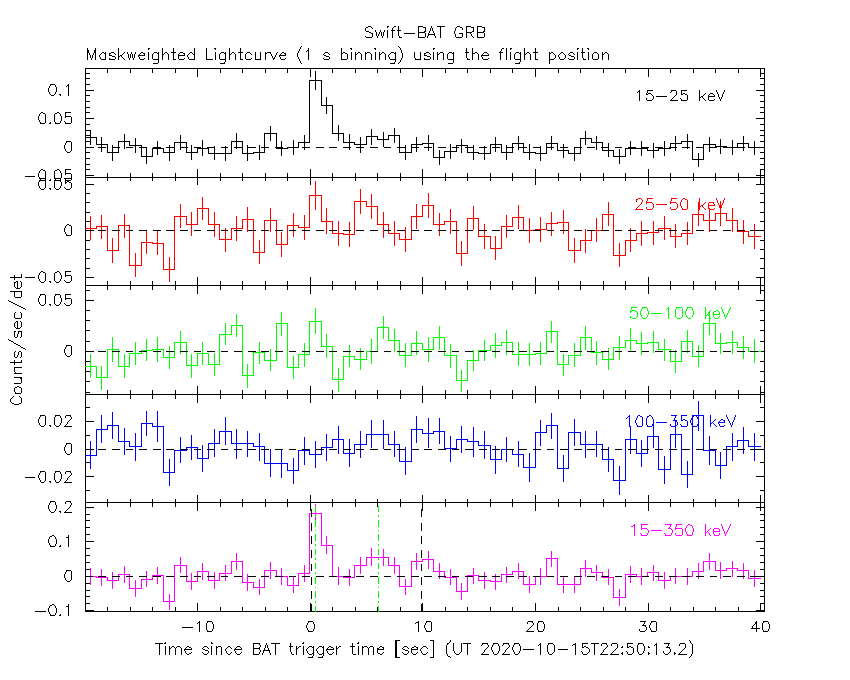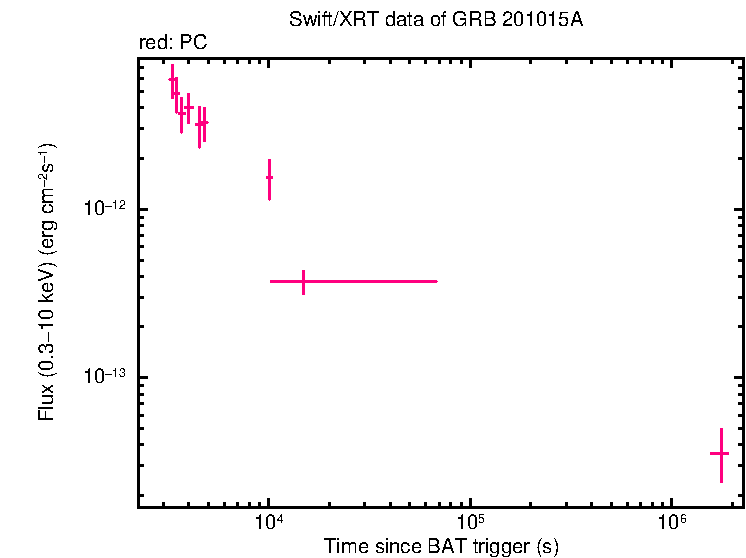
V. D'Elia (SSDC), A. D'Ai (INAF-IASFPA) and F.E. Marshall (NASA/GSFC) for the Swift team
At 22:50:13 UT, the Swift Burst Alert Telescope (BAT) triggered and located GRB 201015A (trigger=1000452) (D'Elia et al. GCN Circ. 28632). Swift did not slew immediately to the burst due to an observing constraint. At the time of the trigger, the initial BAT position was 131° from the Sun (10.2 hours East) and 124° from the 1%-illuminated Moon. Table 1 contains the best reported positions from Swift, and the latest XRT position can be viewed at http://www.swift.ac.uk/xrt_positions.
Malesani et al. (GCN Circ. 28637) reported the position from NOT for the optical afterglow of this GRB. Marshall and D'Elia (GCN Circ. 28662) reported the detection with UVOT of an optical afterglow. de Ugarte Postigo et al. (GCN Circ. 28649) determined a redshift of 0.426 from GTC, and Izzo et al. (GCN Circ. 28661) determined a redshift of 0.423. Table 2 is a summary of GCN Circulars about this GRB from observatories other than Swift.
Standard analysis products for this burst are available at https://gcn.gsfc.nasa.gov/swift_gnd_ana.html.
As reported by Markwardt et al. (GCN Circ. 28658),
the BAT ground-calculated position is RA, Dec = 354.310, 53.446 deg which is RA(J2000) = 2
The mask-weighted light curve (Figure 1) shows a short-soft structure with several overlapping pulses that start at ~
The time-averaged spectrum from T+0.02 to T+10.35 s is best fit by a simple power-law model.
The power law index of the time-averaged spectrum is 3.03 ± 0.68.
The fluence in the 15-150 keV band is 2.0 ± 0.6 x 1
The results of the batgrbproduct analysis are available at https://gcn.gsfc.nasa.gov/notices_s/1000452/BA/.
Analysis of the initial XRT data was reported by D'Ai et al. (GCN Circ. 28660). We have analysed 7.2 ks of XRT data for GRB 201015A, from 3.2 ks to 57.3 ks after the BAT trigger. The data are entirely in Photon Counting (PC) mode.
The light curve (Figure 2) can be modelled with a power-law decay with a decay index of α=1.49 (+0.24, -0.21).
A spectrum formed from the PC mode data can be fitted with an absorbed
power-law with a photon spectral index of 2.2 ± 0.4. The
best-fitting absorption column is 2.3 (+4.6, -2.3) x 1
Analysis of the UVOT data was reported by Marshall and D'Elia (GCN Circ. 28662).
Table 3 gives preliminary
magnitudes using the UVOT photometric system
(Breeveld et al. 2011, AIP Conf. Proc., 1358, 373).
No correction has been made for the expected extinction in the Milky Way
corresponding to a reddening of

Figure 1. The BAT
mask-weighted light curve in the four individual and total
energy bands. The units are counts

Figure 2. The XRT light curve.
Any data from a crosshatched region are not included in the fit.
| RA (J2000) | Dec (J2000) | Error | Note | Reference |
|---|---|---|---|---|
| 2 |
+53°24'57.6" | 1.7" | XRT-final | UKSSDC |
| 2 |
+53°24'57.7" | 1.7" | XRT-enhanced | Evans et al. GCN Circ. 28647 |
| 2 |
+53°26'45.0" | 2.9' | BAT-refined | Markwardt et al. GCN Circ. 28658 |
| Band | Authors | GCN Circ. | Subject | Observatory | Notes |
|---|---|---|---|---|---|
| Optical | Lipunov et al. | 28633 | Swift GRB201015.95: Global MASTER-Net OT detection |
MASTER | detection |
| Optical | Lipunov et al. | 28634 | Swift GRB 201015A: Global MASTER-Net observations report |
MASTER | |
| Optical | Malesani et al. | 28637 | NOT optical afterglow confirmation | NOT | detection |
| Optical | Ackley et al. | 28639 | GOTO confirmation of afterglow detection | Gravitational-wave Optical Transient Observer | detection |
| Optical | Hu et al. | 28645 | BOOTES-1 early optical afterglow detection |
BOOTES-1 | detection |
| Optical | de Ugarte Postigo et al. | 28649 | Redshift from GTC/OSIRIS | GTC | redshift |
| Optical | Zhu et al. | 28653 | Nanshan/NEXT early optical observations | Xinjiang Astro. Obs. | detection |
| Optical | Belkin et al. | 28656 | CrAO/ZTSH optical observations | CrAO | detection |
| Optical | Jelinek et al. | 28664 | FRAM-ORM afterglow detection | FRAM | detection |
| Optical | Belkin et al. | 28673 | Assy and Mondy optical observations | Mondy | detection |
| Optical | Grossan et al. | 28674 | NUTTelA-TAO / BSTI Early Measurements (Preliminary) |
NUTTelA | |
| Optical | Rastinejad et al. | 28676 | MMT afterglow imaging | MMT | detection |
| Optical | Zhu et al. | 28677 | Xinglong-2.16m optical observations | Xinglong | |
| Optical | Kumar et al. | 28680 | HCT optical photometric follow-up | Himalayan Chandra Telescope | |
| Optical | Kumar et al. | 28681 | GROWTH-India Telescope (GIT) upper limit | GROWTH-India | upper limits |
| Optical | Moskvitin and Aitov | 28721 | SAO RAS optical observations | SAO RAS | detection |
| Optical | Pozanenko et al. | 29033 | optical observations and supernova identification |
CrAO | light curve |
| Optical | Rossi et al. | 29306 | evidence of supernova in LBT spectra | LBT | |
| Radio | Fong et al. | 28688 | 6 GHz VLA radio afterglow candidate detection |
VLA | detection |
| Radio | Giarratana et al. | 28939 | radio afterglow with e-MERLIN | e-MERLIN | detection |
| Radio | Rhodes et al. | 28945 | L-band observations with e-MERLIN | e-MERLIN | |
| Radio | Marcote et al. | 29028 | 5-GHz radio afterglow detection with the EVN |
detection | |
| X-ray | Gompertz et al. | 28822 | Late X-ray Detections with Chandra | Chandra | detection |
| Gamma-ray | Blanch et al. | 28659 | MAGIC observations of GRB 201015A: hint of very high energy gamma-ray signal |
MAGIC | |
| Gamma-ray | Fletcher and Veres | 28663 | Fermi GBM Sub-Threshold Detection | Fermi GBM | |
| Other | Izzo et al. | 28661 | redshift confirmation | redshift | |
| Other | Minaev and Pozanenko | 28668 | classification as long GRB |
| Filter | Exp(s) | Mag | ||
|---|---|---|---|---|
| white | 3217 | 3367 | 147 | 20.69 ± 0.28 |
| white | 4402 | 4602 | 197 | 20.33 ± 0.16 |
| v | 3375 | 4949 | 331 | >19.3 |
| b | 4197 | 4397 | 197 | 20.47 ± 0.33 |
| u | 3991 | 4191 | 197 | >19.7 |
| w1 | 3786 | 3986 | 197 | >19.3 |
| m2 | 3579 | 3779 | 197 | >18.8 |
| w2 | 4608 | 4808 | 197 | >19.4 |
Table 3. UVOT observations reported by Marshall and D'Elia (GCN Circ. 28662). The start and stop times of the exposures are given in seconds since the BAT trigger. The preliminary detections and 3-σ upper limits are given. No correction has been made for extinction in the Milky Way.
January 17, 2021